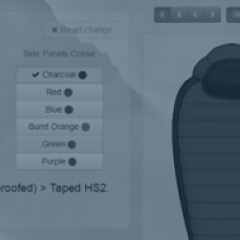Cleaning Down Sleeping Bags & Clothing
Down is naturally very resilient
Some years ago, when testing the effects of repeated compression on down and various synthetic waddings, we found that after thousands of compression cycles the waddings had all lost between 30% and 40% of their loft, as expected. By contrast the down was 5% loftier than before - the compressions had merely warmed it up! This illustrates that down is not the fragile touch-me-not substance some people think. Treated right, it will give good service for a very long time.
Basic Care Rules:
- Store loose, not compressed
- If it gets wet, dry thoroughly before storage
- Keep clean if possible. Using a liner or wearing clothing inside a bag will help by absorbing body oils and sweat
- If it needs cleaning, follow the advice below.
Dirty Marks
Small dirty marks on the shell fabric may respond to wiping with a damp cloth. If you decide to use a stain remover (not recommended for use on our HS3, HS2 and other proofed fabrics), use sparingly and make you sure give the item a good airing before use.
Washing at home
To clean the whole item, down and all, washing is the only way to do it yourself. Clothing can be put through a washing machine. Sleeping bags are best done in the bath. Even with bags it is not a difficult process, following certain simple steps (it looks a lot, but it isn't). It is only the drying which can take a long time.
Clothing (machine washing is described; for hand washing, see sleeping bags).
- Use a pure soap product. These are not easy to find now, so you may need to buy something designed for the job from an outdoor shop: if you do, the package will carry its own instructions, so you can follow them, or carry on as below.
- Set the washing machine for 'delicate' or 'wool' or the equivalent low temperature wash (usually 30 degrees). Use a side-loading machine.
- After it has gone through the spin cycle, most of the water will be out. But it will still need drying. A spell in a tumble dryer will help: lowest heat setting: hot spots may melt the shell fabric. After that air it in a warm place and give it a shake from time to time until you are satisfied that it is completely dry.
Sleeping Bags:
- Use a pure soap product as in 1) above.
- Part fill your bath with warm water (hand-heat). Mix in the soap. Put in the bag and submerge it: this can be made easier by having the bag in its mesh storage sac until it is wet through, then drawing it out gently in the water (do not lift). Note: if the bag is made with a water-resistant outer such as Drishell or Ultrashell, it is much easier to wash it inside out.
- Move the bag about in the water and squeeze it gently to work the soap right through it. Do not pick it up, or the weight of the waterlogged down may damage the baffles.
- Leave it for 30/40 minutes. Repeat step 3), then pull out the plug and let all the water out. Without lifting the bag, squeeze the water out by rolling it up gently.
- Refill the bath with warm water and move the bag about to rinse the soap out. Drain and squeeze out as before. Rinse again. You may have to do this a few times before you get all the soap out.
- Drying: If you can put the bag through the final spin cycle on a washing machine, it will give you a good start: if not, let it drip for a while. After that a tumble dryer on the lowest heat setting (hot spots can melt the shell fabric) will remove even more moisture. In the end, even if the bag feels dry on the outside, you will almost certainly have to keep it somewhere warm and airy for a while (days) while the last of the moisture comes out of the down. Give it a shake from time to time during this last stage to loosen the down clumps. Persist until you feel that the down is truly fluffy and free-moving again.
Allowed to dry naturally hanging in a warm and airy home, it can take a week to 10 days to dry a lightweight bag completely and a full two weeks for an expedition bag. Again, if the outer is a water-resistant fabric such as Drishell or Ultrashell the bag will dry more effectively if turned inside out.
Notes of caution
The most common mistake people make when washing a down item is not drying it fully. As we said, persist. The other thing they sometimes get wrong is setting the heat too high on a tumble dryer (or using a machine with poor heat control) and melting the shell fabric. Take care.
Paying for Cleaning
Commercial washing or dry cleaning is possible if you can find the right people to do it. You will have to make sure that the company has proper experience of this work: cleaning down quilts is a start, but outdoor down gear has specific problems of its own.
Washing: All the same precautions apply as with washing the item yourself. It is not just the down which needs this care, it is the fabrics as well. There are probably a number of capable cleaners around the UK (sorry, we have no knowledge of the situation in other countries). But from personal experience we can recommend Classiclean of Harrogate, who have done a first-class job for us on heavily-used expedition gear:
Classiclean
Unit 4
Claro Court Business Centre
Claro Road
Harrogate
North Yorkshire
HG1 4BA
Tel: 01423 520930
http://www.classicleanofharrogate.co.uk/
More info
Dry Cleaning: Generally not recommended, because many dry-cleaning fluids can damage the down or the proofing on the fabrics or both. If you find someone who really does know how to do the job properly, make sure you air the item fully afterwards (particularly sleeping bags) to get rid of fumes, which can be dangerous.
More on down:




















